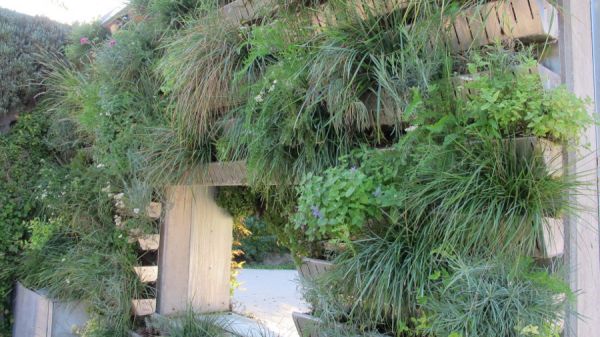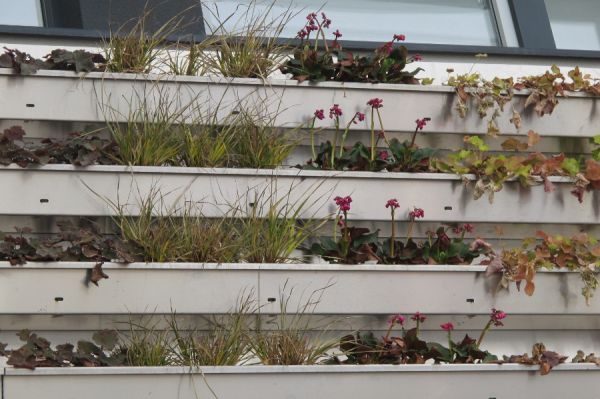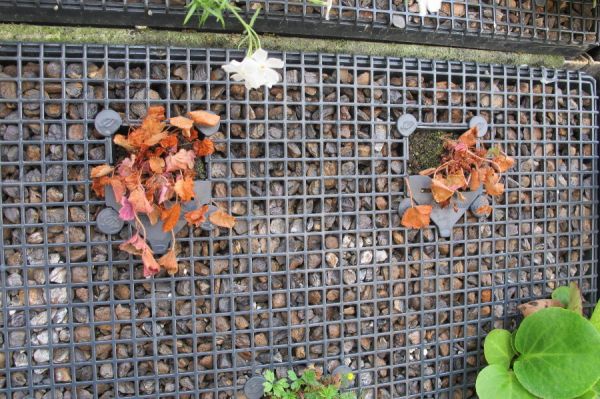greening UP! Sustainable green maintenance, maintenance, maintenance of vertical greenery including legal aspects
Short Description
Motivation and Research Question
Vertical greenings are innovative and complex structures that should be planned and functionally coordinated in accordance to the building structures right from the start. Vertical greenings interact with multiple disciplines, which are not yet considered in planning and building processes. In terms of construction work, (technical) aspects regarding construction physics, structural engineering calculation and façade elements need to be included. As a matter of fact, vertical greenings (especially wall-bound greening systems) from a landscape gardening point of view are sensitive and extreme habitats, which respond particularly sensitive to technical defects. This fact is often disregarded. Insufficient or no water supply, lack of exposure to light or the absence of expert maintenance measures (such as plant protection and fertilization) can cause immense damage. The consortium has made the experience that greenings are often "left" to their owners after completion, without providing them with specific maintenance information. Maintenance and care of vertical greenery is therefore neglected in many cases of exterior or interior greenings. When innovative façade- or plant-through-based vertical greening systems are considered as a "technological product" exclusively (which is often the case), these products are sold high-priced and without guidance of how to maintain greenery and technical components properly. However, what is left out are profound and holistic concepts for long-term care and maintenance for the respective greening system, which focus on the "living building material plant".
Status Quo
The number of urban green spaces is declining, while climate change leads particularly in urban areas to heat islands. Therefore, structural greening is getting more and more important. Vertical greenings, such as complex façade-based greening or ground-based greening in outdoor spaces, function as an effective countermeasure. Because vertical greenings hardly require any additional (surface) areas, they offer extensive potential in implementation, especially against the backdrop of post-compaction development in cities. Not only do they affect the urban climate in a positive way, interior and exterior vertical greenings also enhance human well-being. They improve city dwellers' quality of life in their surrounding environment. Vertical greenings thus combine positive effects regarding environment and microclimate and the improvement of the quality of life in urban areas.
Project Content and Goals
The overall objective of the research and development project "greening UP!" was to develop tailored, innovative and target-group oriented support and concepts for maintenance, servicing and care of vertical greening systems as well as for control and regulation after completion, by taking into account legal framework conditions as well. As a first step, comprehensive surveys and analyses of selected outdoor vertical greening systems (ground-based and system-bound façade greening systems) and indoor vertical greening systems were conducted by involving user groups and stakeholders. Subsequently, concepts for plant care, maintenance and servicing as well as control and regulation of greening systems were developed. (Building) legal aspects of façade greening have been taken into account as well.
Methodological Approach
In the "greening UP!" project, initially comprehensive surveys and analyses of selected outdoor vertical greenings of buildings (soil-, plant-trough- and wall-based vertical greening) as well as five indoor vertical greenings were carried out. Various user groups and stakeholders have been included in that process. Focus was placed on the state of maintenance and preservation, accessibility, vegetation and construction aspects, as well as on organisational and legal framework conditions. The surveys include information on plant care (responsibilities, wishes, needs) and a quality survey (status quo) of the vertical greenings from different point of views (vegetation technology, landscape planning, rainwater management, constructional engineering, construction physics, accessibility, suitability for climbing, social aspects of use and maintenance as well as legal aspects). Based on the analyses and surveys, target group-oriented concepts and recommendations for green care, maintenance and servicing as well as for the regulation of irrigation systems were developed. Legal aspects of vertical greening regarding property boundaries, among other things, have been taken into account.
Results and Conclusions
The project results show that it is often planning and execution errors that have a negative impact on subsequent green care, maintenance and servicing. Deficiencies in the dimensioning and design of the irrigation technology or insufficient accessibility of important components for maintenance, such as control and regulation technology, very often lead to operational problems. Retrospective corrections, if possible, often stand for huge efforts. Additionally, a lot of vertical greening systems do not provide sufficient accessibility when it comes to greenery maintenance measures. Planning and execution very scarcely consider possibilities for including ladders or additional anchor points for industrial climbers, although these components would facilitate accessing the green walls much more quickly and spontaneously. Furthermore, continuity in competences and responsibilities plays an essential role. Especially when responsibilities are handed over, for example when greening is completed and transferred to ongoing operations, clear responsibilities are an essential guarantor regarding a successful greening project. Legal agreements and the consideration of legal aspects are able to provide essential support as well.
Outlook
Greening as a technical, however living system has to be clearly more emphasised as a part of the planning process and also included and documented throughout the whole process. This applies not only to architectural and façade design, but also to technical details, e.g., building services, water supply, static requirements, building physics, fire protection, accessibility, etc. Future vertical greenings should already be co-developed and incorporated into the building project within initial ideas and planning steps. This will require increased interdisciplinary cooperation between a wide range of disciplines such as landscape planning, landscape architecture, vegetation technology and landscape construction as well as architecture, building services, façade technology, building physics and statics. The involvement of specialist contractors as early as the planning phase begins is appreciated as well. Vertical greening should always be considered as a living system, hence paying attention to the interface human beings – technology – nature is of major importance! Planning and construction documentation from the beginning and a comprehensive documentation of the green care and maintenance in the ongoing operation are of great importance
Project Partners
Project management
Dipl.-Ing. Ralf Dopheide e.U.
Project or cooperation partners
- Technische Universität Wien, Institut für Hochbau und Technologie
- Büro für nachhaltige Kompetenz B-NK GmbH
- TreeBee-Iring Süss e.U.
- Universität für Bodenkultur Wien, Institut für Ingenieurbiologie und Landschaftsbau (IBLB), Mag. Peter Skolek
Contact Address
Dipl.-Ing. Ralf Dopheide e.U.
Dipl.-Ing. Ralf Dopheide
Schönbrunner Straße 59-61/10
A-1050 Wien
Tel.: +43 (699) 10840733
Mail: office@dopheide.at
Web: www.dopheide.at




